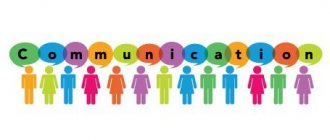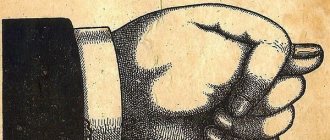negotiations for managers
15.07.2020
Author: Academy-of-capital.ru
Add a comment
Rating:
| (Votes: 3, Rating: 4.33) |
From this material you will learn:
- The need to understand nonverbal communication.
- Differences between verbal and nonverbal communication.
- 6 means of nonverbal communication.
- What do these or other gestures mean?
- Postures for open communication and alarming ones.
- 19 types of facial expressions.
- Psychology of wardrobe.
Nonverbal communication is what brings a person to the surface. If he says one thing, but demonstrates something else with his gestures and facial expressions, then you shouldn’t do business with him, since he is either hiding something, or keeping something back, or even worse, lying. In addition, gestures, voice timbre and clothing can also say a lot about the interlocutor.
Everyone needs to know all the tricks of nonverbal communication, not only in order to figure out the interlocutor. This knowledge will help you behave when communicating with people according to the thoughts in your head, demonstrating sincerity and not giving rise to doubts.
The need to understand nonverbal communication
Let's start with the fact that nonverbal communication is body language (gestures, postures, intonations), influencing a person through facial expression and demeanor, that is, non-verbal transmission of information without words. Experts often call this type of communication nonverbal.
The history of bodily signals began much earlier than verbal communication. Ancient people expressed themselves by body movements (tilting the head, waving the arms, moving the body). By analogy with animals, man put different meanings into dynamics. Later, people began to make sounds in the form of mooing. Timbre and intonation appeared, now called paralinguistics. Much later, methods of verbal communication emerged that complemented existing communications.
Today, nonverbal communication in the communication of a modern person makes up 60%. This is what we express with gesture, posture, facial expressions. Another 30% of information is conveyed through intonation and vocal sounds. As a result, 90% of the information a person communicates is not perceived from the meaning of the speech.
Typically, wordless communications occur subconsciously and very rarely occur intentionally. Therefore, specialists who understand body language are able to read a lot from gestures. Undoubtedly, it is easier to use speech, but many do not even think that they can give signals through movement, facial expressions and gestures, and therefore do not try to control them. But a person who understands this issue is able to understand the true attitude of the interlocutor by reading non-verbal signs. After all, they reflect a person’s real feelings, his attitude to what is happening and the environment.
But there is another side to the issue. Nonverbal communication between people is a great clue for specialists. Someone who is good at non-verbal communication, which is quite possible, will express their thoughts clearly. In any case, those around him will understand him more accurately.
Body language is often used for personal manipulation, as well as manipulative games. All these actions influence the subconscious of the partner, who does not understand them and instinctively submits to someone else’s will. Misunderstood non-verbal language is fertile ground for manipulation in everyday life.
Features of business rhetoric. Nonverbal means in business communication
| Item: | Economy |
| Kind of work: | Essay |
| Language: | Russian |
| Date added: | 05.07.2020 |
- This type of work is not a scientific work, it is not a finished final qualifying work!
- This type of work is a finished result of processing, structuring and formatting collected information intended for use as a source of material for independent preparation of educational work.
If you have a hard time understanding this topic, write to me on WhatsApp, we’ll look into your topic, agree on a deadline, and I’ll help you!
If you want to learn how to correctly carry out and write abstracts on any subject, then on the page “what is an abstract and how to do it” I wrote in detail.
Look at similar abstract topics, they may be useful to you:
| Specific pros and cons of Keynesian and liberal approaches regarding the realities of the Russian economy |
| The situation with fixed assets in Russia in recent years. 10 years |
| Business centers over the past 5 years |
| Features of the fuel and energy complex of Canada at the present stage |
Introduction:
A person perceives much more with his eyes than with his ears. Most information is conveyed through nonverbal communication. Many gestures are not recorded by consciousness, but completely convey a person’s mood and thoughts. If you want to be known as an attentive and interesting conversationalist, then you need to understand gestures and facial expressions. Facial expressions and gestures play a big role in how others assess the level of education of the interlocutor.
Body language can be used to mislead and manipulate people. There are times when this is exactly what is necessary.
Understanding the intricacies of body language can improve and simplify your relationships with the people around you.
Nonverbal features in the process of business communication
People can exchange different types of information at different levels of understanding. It is known that communication is not limited to oral or written messages. Your partner's emotions, mannerisms and gestures play an important role in this process. Psychologists have found that in the process of human interaction, from 60 to 80% of communication is carried out by non-verbal means of expression, and only 20-40% of information is transmitted using verbal means. These data make us think about the importance of nonverbal communication for mutual understanding between people, pay special attention to the meaning of human gestures and facial expressions, and also generate a desire to master the art of interpreting this special language in which we all speak without even realizing it.
The peculiarity of non-verbal language is that its manifestation occurs thanks to the impulses of our subconscious, and the lack of the ability to imitate these impulses allows us to trust this language more than the usual verbal channel of communication.
The success of any act of business communication largely depends on the ability to establish trusting contact with the interlocutor, and such contact depends not so much on what you say, but on how you behave. That is why special attention should be paid to the manner, posture and facial expressions of the interlocutor, as well as how he gestures.
Understanding the language of facial expressions and gestures allows you to more accurately determine the position of your interlocutor. By reading gestures, you provide feedback that plays a critical role in the overall process of business interaction, and the combination of gestures is an important component of such communication.
Knowledge of body language and body movements allows you not only to better understand the interlocutor, but also to predict the impression that what you hear will make on him, even before he speaks about it. This kind of wordless language can alert you to whether you should change your behavior or do something else to achieve a desired outcome.
Proxemic features of nonverbal communication
Space and time in business communication also act as a special sign system and carry a semantic load. Placing partners facing each other promotes contact and symbolizes attention to the speaker.
This is due to the following: it was recently discovered that a person has his own “security” zones and territories, characteristic of different types of communication. The American scientist E. Hall was one of the first in the field of studying human spatial needs and in 1969 published the book “Silent Language”. He also coined the term “proxemics”. This is the distance that people keep, and this is a biological pattern.
The dimensions of a person’s personal spatial territory can be divided into 4 zones:
- intimate zone - from 15 to 45 cm;
- personal zone - from 46 to 120 cm;
- social zone - from 120 to 360 cm;
- public or public area - more than 360 cm.
The intimate area is the most important. It is this zone that a person protects as if it were his property. The personal zone is the distance that usually separates us when we are at official receptions and friendly parties. The social zone is the distance we keep from people we don’t know very well. The public zone is the distance that is maintained when we address a large group of people. Crowding of people at concerts, in cinema halls, on escalators, in transport and in elevators leads to the inevitable invasion of each other's intimate areas. There are a number of unwritten rules for Europeans in crowded situations, such as on a bus or in an elevator. These are the following rules:
- You are not allowed to talk to anyone, not even your acquaintances;
- It is not recommended to look directly at others;
- the person must be completely impartial - no display of emotions is allowed;
- if you have a book or newspaper in your hands, then you should be completely immersed in reading;
- the more crowded it is in transport, the more restrained your movements should be;
- In the elevator, you should only look at the floor indicator above your head.
The choice of distance depends on the relationship between people (as a rule, people stand closer to those with whom they sympathize) and on the individual characteristics of the person (for example, introverts do not tolerate too close a distance).
Proxemic behavior includes not only distance, but also the mutual orientation of people in space. Friends are nearby, participants in a business conversation are across the corner of the table, competitors are across the table. For example, according to European rules of etiquette in a restaurant or cafe, a lady or respected person is offered a seat with his back to the wall. This provides the greatest psychological comfort.
The relationships between people unfold not only in space, but also in time. How a person manages other people's and his own time is an important social sign. Respect for another person is manifested in increased accuracy and punctuality of behavior. Making another wait means, wittingly or unwittingly, declaring your right to control the situation. The time factor is very important in a society where “time is money”, so it is important not to waste time. In this, in particular, we need to look for the source of punctuality among businessmen.
There are spatial rules of interaction between participants in communication, and they need to be known and followed.
Let's consider the placement of negotiators in a working office at a standard rectangular table with four positions of your interlocutor:
- corner location;
- business interaction position;
- competitive-defensive position;
- independent position.
The corner position is typical for people engaged in friendly, casual conversation. This position promotes constant eye contact and provides space for gestures and the opportunity to observe the gestures of the interlocutor. The corner of the table serves as a partial barrier in case of danger or threat from the interlocutor. With this arrangement, there is no territorial division of the table. When two people collaborate on a problem, they usually adopt a transactional attitude. This is one of the most successful strategic positions for discussing and developing common solutions. Positioning partners opposite each other usually creates an atmosphere of competition.
This arrangement of interlocutors helps ensure that each side adheres to its own point of view. The table between them becomes a kind of barrier. In addition, if the meeting takes place in an office, then this arrangement also indicates a relationship of subordination. It should be remembered that a competitive-defensive position makes it difficult to understand the point of view of the interlocutors and does not create a relaxed atmosphere. Greater mutual understanding can be achieved in the angular position and in the position of business interaction than in the competitive-defensive position. Conversation in this position should be short and specific. There are times when it is very difficult or inappropriate to take an angular position when presenting your material. Let's say you need to offer a sample, diagram, or book for consideration to the person sitting across from you at a rectangular table. First, place what you want to present on the center line of the table. If he leans forward to get a better look at your material, but does not move it to his side, then this means that your material is of little interest to him. If he moves the material to his side of the table, this means that he has shown interest in it. This makes it possible to ask permission to go to his side and take either a corner position or a position of business cooperation.
However, if he pushes away what you brought him, then the deal will not go through, and you need to end the conversation as quickly as possible. People who do not want to interact with each other at the table take an independent position. This position indicates a lack of interest. It should be avoided when frank conversation or interested negotiations are required. The creation of a psychological climate during communication is significantly influenced not only by the location of the interlocutors at the table, but also by the shape of the tables themselves. Thus, a square table contributes to the creation of relations of rivalry between people of equal status. Square tables are good for holding a short business conversation or for emphasizing chain of command. The maximum resistance will be provided by the person sitting directly opposite you. At a rectangular table at a meeting of people of the same social status, the dominant place is considered to be the one on which the person sitting facing the door is sitting. A round table creates an atmosphere of informality and ease, and it is best to hold conversations with people of the same social status. In addition, when you have to conduct a business conversation with two interlocutors, one of whom is very talkative and the other, on the contrary, very silent, it is advisable to sit at a round table. In order for all partners to take an active part in the conversation, you should use a simple but very effective technique: when a talkative interlocutor asks a question, while answering, look first at him, and then turn your head towards the silent interlocutor, then again towards the talkative one, and then again - towards the silent one. This technique allows the less talkative interlocutor to feel that he is also involved in the conversation, and it allows you to gain the favor of this person (this means that you can get support from him, if necessary). Thus, a square (or rectangular) table, which is usually a work desk, is used for business conversations, negotiations, and briefings. A round table is most often used to create a relaxed, informal atmosphere and is good when you need to reach an agreement. You should not only choose the right shape of the table, but also be able to seat your interlocutor at it in such a way as to create maximum psychological comfort. This is especially important when you invite him to a formal dinner at your home or restaurant. Try to make sure that your interlocutor sits with his back to the wall. Psychologists have proven that a person’s breathing rate and heart rate increase if he sits with his back to an open space, especially if there is constant walking behind his back. In addition, tension increases when a person’s back is turned towards the front door or window, especially if it is a first floor window.
Nonverbal communication
The effectiveness of communication is determined not only by the degree of understanding of the words of the interlocutor, but also by the ability to correctly assess the behavior of the participants in communication, their facial expressions, gestures, movements, posture, direction of gaze, that is, to understand the language of non-verbal (verbal - “verbal, oral”) communication. This language allows the speaker to more fully express his feelings, shows how much the participants in the dialogue control themselves, and how they really relate to each other.
The look is sympathetic, encouraging, interested. He inspires confidence and encourages frank conversation. Your interlocutor hopelessly waved his hand, looked away to the side, and you understand without words that he does not believe you, considers the current situation hopeless. And no matter how hard some people try to control their behavior, monitor their facial expressions and gestures, this is not always possible. Nonverbal communication “gives away” the interlocutors, sometimes casts doubt on what was said, and reveals their true face. Therefore, we must learn to understand this language.
Facial expressions
The main indicator of the speaker's feelings is his facial expression. In “Private Rhetoric” by professor of Russian and Latin literature N. Koshansky (St. Petersburg, 1840) there are the following words: “Nowhere are the feelings of the soul reflected so much as in the facial features and gaze, the noblest part of our body. No science gives fire to the eyes and a lively blush to the cheeks if a cold soul sleeps in the speaker... The body movements of the speaker are always in secret agreement with the feeling of the soul, with the aspiration of the will, with the expression of the voice.”
Facial expressions allow us to better understand our opponent and understand what feelings he is experiencing. Thus, raised eyebrows, wide open eyes, lowered tips of the lips, a slightly open mouth indicate surprise, lowered eyebrows, curved wrinkles on the forehead, narrowed eyes, closed lips, clenched teeth express gayness.
Sadness is reflected by knitted eyebrows, dull eyes, slightly lowered corners of the lips, and happiness is reflected by calm eyes and raised outer corners of the lips.
For everyone participating in a conversation, on the one hand, it is important to be able to “decipher” and “understand” the facial expressions of the interlocutor. On the other hand, it is necessary to know to what extent he himself masters facial expressions, how expressive it is.
Gesticulation
The gestures of the interlocutor can also say a lot. We can’t even imagine how many different gestures a person uses when communicating, how often he accompanies his speech with them. And here's what's surprising. Language is taught from childhood, and gestures are acquired naturally, and although no one explains or deciphers their meaning in advance, speakers correctly understand and use them. This is probably explained by the fact that the gesture is most often used not on its own, but accompanies the word, serves as a kind of support for it, and sometimes clarifies it.
In the Russian language there are many stable expressions that arose on the basis of free phrases naming this or that gesture. Having become phraseological units, they express a person’s state, his surprise, indifference, embarrassment, confusion, dissatisfaction, resentment and other feelings, as well as various actions. For example: lower your head, turn your head, raise your head, shake your head, the hand does not rise, spread your arms, lower your arms, wave your hand, put your hand on your heart, put your hand on, extend your hand, wag your finger, show your nose.
Gestures, gestures, gestures
The famous ancient orator Demosthenes, when asked what is needed to be a good orator, answered: “Gestures, gestures and gestures!”
It is no coincidence that in various rhetorics, starting from ancient times, special chapters devoted to gestures were allocated. Oratory theorists, in their articles on lecturing, also paid special attention to gestures. A.F. Koni writes in “Advice for Lecturers”: “Gestures enliven speech, but they should be used carefully. An expressive gesture (raised hand, clenched fist, sharp and fast movement, etc.) must correspond to the meaning and meaning of a given phrase or individual word (here the gesture acts at the same time as Eton, doubling the power of speech). Too frequent, monotonous, fussy, sharp movements of the hands are unpleasant, boring, boring and irritating.”
As can be seen from the quote, Koni emphasizes the meaning of gesture: a gesture clarifies a thought, enlivens it, in combination with words enhances its emotional sound, and contributes to a better perception of speech. At the same time, A.F. Koni notes that not all gestures make a favorable impression. Indeed, it is bad if the speaker tugs at his ear, rubs the tip of his nose, straightens his tie, twirls a button, that is, repeats some mechanical gestures that are not related to the meaning of the words.
Rhythmic Gestures
Rhythmic gestures are related to the rhythm of speech. Watch speakers on TV, see how often the speaker waves his hand in time with his speech. Rhythmic gestures emphasize logical tension, slowing and accelerating speech, the place of pauses, that is, what is usually conveyed by intonation.
Say, for example, proverbs:
- "He says he's cutting water"
- “Scribbles like a machine gun, accompanied by rhythmic gestures.”
When pronouncing the first proverb, we make a slightly slow movement of our hand to the right. In this case, vowel sounds are pronounced somewhat stretched out. In the second case, we make frequent vertical movements with the edge of the palm of the right hand, reminiscent of shredding cabbage.
Emotional Gestures
Our speech is often emotional. Excitement, joy, delight, hatred, grief, irritation, bewilderment, confusion, confusion - all this is manifested not only in the choice of words, intonation, but also in gestures. Gestures that convey a variety of shades of feelings are called emotional. Some of them are fixed in stable combinations, since such gestures have become universal. For example: hit yourself in the chest, hit the table with your fist, slap (hit) yourself on the forehead, turn your back, shrug your shoulders, spread your arms, pointing to the door.
Pointing gestures
Tell me, is it possible to carry out orders: “Open that window”, “Don’t take this book, take that one” if they are pronounced without a gesture? There will be only one answer: “No!” In such situations, a pointing gesture is required. With their help, the speaker identifies some object from a series of homogeneous ones, shows a place - next, above, above us, there, emphasizes the order of succession - in turn, through one.
You can point with a glance, a nod of the head, a hand, a finger (index, thumb), a foot, or a turn of the body.
Some pointing gestures are conventional. So, when the speaker points to his chest - on the left, where the heart is, saying: “He (the gesture) has nothing here,” then it is clear that we are talking about a heartless, insensitive person.
There are cases when the decoding of a gesture is determined by the situation. Here are some examples:
Iconic gestures
Now let's do an experiment. Ask someone near you or close to you the question: “What is a spiral staircase and ripples in the water?” In response you will hear: “This is a ladder (vertical rotation is done with the right hand). And ripples... (wavy horizontal movement of the hand). “Ask this question to anyone and as many times as you like, and you will see that almost everyone cannot do without a gesture, although the dictionary definition (interpretation) is not so difficult to give: a spiral staircase is a spiral staircase; ripples are slight vibrations of the water surface, as well as light waves from such vibrations. But the gesture seems to be clearer, it depicts the object, shows it, so preference is given to the gesture, which is called pictorial.
Graceful gestures appear in the following cases:
- if there are not enough words to fully convey the presentation;
- if words alone are not enough for some reason (increased emotionality of the speaker, lack of self-control, incoherence, nervousness, uncertainty that the addressee understands everything);
- if it is necessary to enhance the impression and influence the listener additionally and visually.
However, when using figurative gestures, one must maintain a sense of proportion: these gestures cannot replace the language of words.
Pose
Posture is a certain position of parts of the human body: head, torso, arms, legs, as well as movements that change or influence this position. It is difficult to analyze a pose, since listing individual elements does little to understand it. The observer perceives the harmony or disharmony of the relationships between the components of a pose and draws a conclusion about its naturalness or unnaturalness, the person’s condition, and his attitude towards others.
Almost every person has his own favorite pose (or poses), so it is not always easy to understand whether a given pose is an expression of the person’s state at the moment or is just a tribute to habit. However, preference for a particular posture may reflect a person's susceptibility to the corresponding condition.
There are only general rules for “reading” poses that apply to most people. At the same time, the unambiguity of understanding depends on the typicality of the pose and the breadth of its distribution. In the most general terms, postures can be divided into two large groups depending on whether the person is sitting or standing. In this regard, some elements of poses receive a semantic interpretation:
- standing with your legs wide apart means the need for self-affirmation, the need for high self-esteem, and often overcompensation for feelings of inferiority;
- a wide, comfortable, heavy seating position covering the entire surface of the seat expresses a person’s desire to enjoy peace and comfort, i.e. “make yourself comfortable”;
- sitting on the edge of a chair with a straight back and fully facing the partner indicates a high degree of interest in the interlocutor and concentration;
- legs crossed or pressed together indicate a person’s pedantic correctness or helplessness;
- hands under the table during business negotiations is a sign of unpreparedness for a conversation or an expression of a feeling of uncertainty or nervousness.
Postures can be classified on the following basis:
- stages of communication - postures of entering and leaving contact;
- types of relationships and relationships - postures expressing likes - antipathies, submission - dominance, inclusion - alienation;
- psychophysiological states - tense and relaxed posture, active and passive;
- correspondence of partners’ postures in communication—synchronous or asynchronous postures;
- direction of the pose - poses of the partners facing each other, back to each other, face to back;
- correspondence of the pose to other elements of expression - the pose is harmonious or disharmonious.
Openness and closedness of posture are also important components of communication:
- an open pose is determined by turning the body and head towards the interlocutor, opening the palms, uncrossed position of the legs, relaxed muscles, and direct gaze into the face; this position of the interlocutor can facilitate contact, “revive” communication, and demonstrate sympathy for the partner;
- a closed pose is characterized by “throwing” the body back, crossed position of the arms and legs, and muscle tension.
Another important parameter of nonverbal communication is the quantitative indicator of changes in postures per unit of time. It has been established that the number of poses taken by a person during communication correlates with his status and desire for dominance. Thus, persons of higher status change their postures more often, make more movements of the head, torso, arms and legs, and also demonstrate more freedom in choosing and changing a certain nonverbal repertoire than their low-status partners. At the same time, pairs of interlocutors that differ in status usually talk while leaning away from each other, while pairs with the same status stand straight.
Thus, for a person striving for contact, mutual understanding, a pleasant facial expression and moderate gestures, an open posture, a slight tilt of the body forward, and involuntary copying of the partner’s non-verbal behavior are characteristic. In the absence of the intention to develop positive relationships, a person resorts to movements that block contact (demonstration of closed postures, turning the body away from the interlocutor, putting arms and elbows forward, stretching legs).
National characteristics of nonverbal communication
The more a culture traces the dependence of communication on the situation, the more attention it pays to nonverbal behavior - facial expressions, gestures, touches, eye contact, spatio-temporal organization of communication, etc.
Conclusion
When communicating, we listen not only to verbal information, but also look into each other’s eyes, perceive the timbre of the voice, intonation, facial expressions, and gestures. Words convey logical information to us, and gestures, facial expressions, and voice complement this information.
Nonverbal communication - communication without words often occurs unconsciously. It can either complement and improve oral communication, or contradict and weaken it. Although nonverbal communication is often an unconscious process, it is now well understood and can be successfully controlled to achieve the desired effect.
Nonverbal communication is the oldest and most basic form of communication. Our ancestors communicated with each other using body tilt, facial expressions, voice timbre and intonation, breathing rate and gaze. We still often understand each other without words.
Nonverbal language is so powerful and universal that we can often easily understand what a dog wants. The dog predicts many of our actions, for example, it knows in advance when we go for a walk with it, and when we go outside without it.
It remains to add that if humans (as well as animals) lacked non-verbal communication, then we would be like machines without feelings and emotions that exchange information with simple printed words (for example: via the Internet), but, for example, not handwritten text - after all handwriting, in a way, is also an object of nonverbal communication.
Differences between verbal and nonverbal communication
Let us recall what verbal interaction is. These are verbal communications between people. They are oral and written. The main conditions for contacts are clear content, clear pronunciation, and clear expression of thoughts.
Language, as a data encoding system, is the main tool for communication. It allows you to describe objects and events, express personal opinions, show emotions and feelings. However, this mechanism of communication makes sense together with certain actions. That is, spoken words must be supported by signs to enhance the effect of interaction.
Note that dactylic speech, which deaf and mute people “speak”, also belongs to verbal communication. Here gestures replace letters.
Taking into account all the definitions, we can conclude that nonverbal communication (signals) differs from verbal communication only in the form of information transmission. The latter involves the use of oral speech or written expression of thoughts. More precisely, the interlocutors convey information to each other in the form of words. This type of communication is only available to people.
The principle of nonverbalism is based on body language. Therefore, the main means of interaction here are postures, gestures, facial expressions, and touches. They perfectly help a person express his thoughts without using words. But at the same time, facial expressions and gestures are characteristic of animals. You obviously know why a dog or cat wags its tail? The first demonstrates its joy, the second - a feeling of dissatisfaction. The beast’s menacing grin warns a person, and a guilty look symbolizes repentance. There are many such examples.
Science has proven that nonverbal communication is much more sincere than verbal communication. The reason is that people are often unable to control their gestures and facial expressions. These are internal signals from the subconscious that reflect everything we experience.
Undoubtedly, speech (both oral and written) is often deceitful. After all, deceiving people over the phone or the Internet is easier than having a conversation in person. When meeting, you can observe the facial expressions and gestures of the interlocutor to notice the obvious discrepancy between emotions and words. To understand how nonverbal and verbal communication differ, let's give a simple example.
Let's say if a seller tells you about the benefits of a product, looking away and nervously fingering some object, it means he is hiding something. As you can see, it is easier to deceive with words than with facial expressions and hand movements.
What do certain gestures mean?
- Unbuttoning a jacket
This is a sign of openness that involves non-verbal communication. Situations when well-meaning people tend to unbutton or take off their jacket in front of their interlocutor are quite common. Practice shows that negotiators in loose clothes are more likely to find compromises than those who are buttoned up with all the buttons. It has been noticed that when making a positive decision, a person usually unclasps his fingers and instinctively pushes the tails of his jacket apart.
When partners realize that they have almost achieved a positive result in the issue under discussion or have worked fruitfully for the benefit of both parties to the negotiations, they tend to unbutton their jackets, straighten their legs and move closer to the edge of the chair in order to get closer to the table and, accordingly, to the opponents sitting opposite them. .
- Mistrust and secrecy
These gestures indicate the interlocutor's suspicion. That he doesn’t believe your words or is hiding something himself. In such situations, people involuntarily rub their chin, forehead or temples, and try to cover their face with their hands. Most often, such individuals look away so as not to look into their partner’s eyes. Another sign of secretive behavior is uncoordinated gestures. If the “aggressor” or your “victim” smiles, then his hostility is hidden behind the insincere smile.
- Protection
With defensive gestures, people show a sense of threat and danger. The most popular sign from this series is crossing the arms in the chest area. When speech is absent, nonverbal communication involves three characteristic situations, which we will describe below.
The usual crossing of arms is a standard gesture that symbolizes dissatisfaction or a defensive posture of the interlocutor. You should change your negotiation strategy, otherwise your opponent will try to avoid answering specific questions. In addition, this sign influences the position of others.
If one of the four participants in a conversation crosses his arms over his chest in defense, it is quite possible that everyone else will follow his example. Of course, in some cases this can be seen as self-confidence and serenity. But only if the conversation is favorable.
We recommend
“Verbal communication: understanding the types and applications” Read more
It happens that in addition to crossing your arms, your opponent clenches his fists. This is a typical sign of aggression and hostility - the negotiator goes on the offensive. You need to slow down your speech and reduce the intensity of your gestures, intuitively inviting your interlocutor to moderate his ardor. If that doesn't work, change the topic of conversation.
Sometimes people criss-cross their shoulders with such force that their fingers, digging into their biceps, turn white. In this way, they restrain the negative emotions that arose in response to your proposal on the current issue. A similar gesture is used if one of the negotiators gets into a discussion, trying to impose their position as the only correct one. In addition to this pose is added a cold gaze with a squinted eye and a tense smile. This body language means that the person is, so to speak, on edge and urgently needs to change tactics in order to reduce tension and avoid conflict.
Quite popular in business circles are arms crossed over the chest with thumbs raised vertically. Nonverbal communication interprets this signal as “two in one”. It means denial (arms crossed) of your position plus your own superiority (hand position). The person using this technique often plays with their fingers or rocks slightly on their heels while standing. The contemptuous gesture of the thumb symbolizes ridicule and disrespect for the one at whom it is supposedly directed over the shoulder.
- Thinking, evaluation
Such gestures demonstrate the work of thought to solve a problem. Thoughtful facial expressions are often accompanied by hands supporting the cheeks. This body position indicates that the opponent is interested in something. You just have to recognize what he was so focused on.
- Tingling between the eyebrows
This is usually done with the eyes closed, which means greater concentration of the mind and intense work of thought. At the problem-solving stage, when the answer is already ready, the interlocutor rubs his chin. Many people accompany their thought process by squinting their eyes, as if looking at distant objects in search of the necessary solution.
- Doubt and indecision
The movements that nonverbal communication dictates to us in this case consist of stroking the side surface of the neck or the area under the earlobe with the index finger (usually 5-6 times). A sign of hesitation will be touching your nose and lightly scratching its tip.
- The desire to isolate yourself
If the interlocutor runs his fingers along the edge of the ear, this means that he does not want to hear your words. Tugging on the earlobe warns the speaker that the person has heard enough and also wants to state his position.
- The desire to leave the interlocutor
When your counterpart intends to stop the dialogue, he slowly (or purely mechanically) turns his body towards the door, pointing his legs towards the exit. The interlocutor seems to demonstrate that he needs to leave. There is another expressive gesture that speaks without words: a man demonstratively takes off his glasses and puts them in a case. Here you need to do something to attract the opponent’s attention or just let him leave. Continuing the conversation in the same spirit will not achieve results.
- Dragging out the conversation
Such gestures are often associated with glasses. To gain time to make a decision, the opponent does this: he takes off his glasses and puts them back on, and wipes the lenses. Once you notice this reaction to a question asked, just wait silently. The interlocutor, putting his glasses back on, shows that he needs to “look at the arguments” again.
- Walking from corner to corner
Another technique that offers people non-verbal communication. A person pacing around the room is sending you a signal - “you shouldn’t rush.” It is used to stall for time when solving complex problems. This is essentially a positive gesture. Don't distract the other person who is walking, otherwise you will interrupt his thoughts and prevent him from making a decision.
- Keep yourself in control
If a person is too upset and wants to curb his emotions, he grabs his wrists behind his back. This gesture should not be confused with the “lock your hands behind your back” position. An interesting fact: the greater the degree of anger, the higher the hand is raised from behind. This is where the phrase “pull yourself together” came from. This negative movement can hide nervousness, but an observant negotiator will sense this signal.
- Disapproval
In other words, these are gestures of repression that arise from unspoken opinions. Let's say the collection of invisible lint on clothing is an example of such a reaction. The participant in the conversation does not like everything that is happening, even if outwardly he agrees. The person who is looking for lint usually sits without looking at others or with his eyes on the floor. This is the most common way to show dissatisfaction.
- Willingness to leave
This body position indicates a desire to end the conversation. In this case, the body is tilted slightly forward, hands are on the knees or holding the seat of the chair. If you notice these movements in a conversation, it’s time to end it and be the first to say goodbye to your opponents. This way you will maintain your priority and maintain control over the situation.
Considering nonverbal communication (features of popular poses and gestures), it should be noted that there are a lot of other techniques that quite expressively convey the state of mind. For example, rubbing your palms reflects joyful anticipation. Intertwined fingers represent the collapse of hopes and the desire to hide one’s annoyance at what one hears.
Methods
In order to produce the desired effect on the interlocutor, non-verbal techniques should be used according to certain techniques. The most common methods:
Kinesics
This is a complex of certain human movements and gestures that make speech more focused. The well-known “gesture language” makes it possible to attract the listener’s attention, emphasize the necessary things and increase or decrease the level of perception of information. In addition, you should pay attention to the interlocutor:
- If he, for example, has his arms crossed at chest level, this means that he is defending himself from you and does not want to perceive the information that you provide him.
- If he fiddles with his hair (here - buttons on clothes or other obsessive movements), this is a sign of fear, apprehension and mistrust or lack of self-confidence.
- If he taps his fingers or pen on the table, this means that the interlocutor is completely uninterested in what you are telling him.
Therefore, you need to be attentive not only to what you do during a conversation, but also to pay attention to the nonverbal feedback of the person with whom you entered into a business conversation.
Tactile method
This is communication using touch. There are 4 types of tactile touches:
- Professional.
- Love ones.
- Friendly.
- Ritual.
Naturally, only professional means of the tactile method are used in work and business activities. If you go too far with this technique, you can simply lose a client. Correct use of the tactile method in business nonverbal communication allows you to instill trust and win over your interlocutor.
Postures for open communication and alarming ones
The ideal position for a frank conversation is open. What do these signs of nonverbal communication look like (gestures, postures, facial expressions):
- hands lie freely on the table, knees or armrests;
- the upper part of the body is straight, but not tense (no need to fall apart in a chair or sit as if you had swallowed a yard);
- the legs stand straight and natural (a crossed position is undesirable), but the “leg to leg” pose is possible and indicates the liberation of the interlocutor;
- attentive, calm look into the eyes;
- keep your head straight (without tilting left or right), do not look from under your brows and do not raise your nose;
- relax, lower your shoulders.
Nonverbal communication in closed positions indicates the interlocutor’s discomfort and his desire to get out of an uncomfortable situation.
What do sitting body positions mean:
- Standard foot-to-foot manner . A nervous, withdrawn person who tries to hide his own vulnerability. The person has a negative attitude towards conversation.
- "American" pose . Warns that your partner is going to challenge or object to you. This is often how leaders and ringleaders behave.
- Completely closed position - crossing of arms (crosswise on the chest) and legs (one thrown over the other) . The opponent does not want to talk to you and is extremely negative.
- Indecisive position . The leg is thrown over the leg, the fingers are folded and hold the upper knee. The interlocutor wants to hide his excitement.
- Defensive position - interlocking feet . Often characteristic of shy people.
- Crossed ankles . They express an attempt to hide their fear, anxiety and negative emotions. The person who took this pose seems to be biting his lips to himself. Such provisions are chosen during inquiries, where it is necessary to control actions and words.










